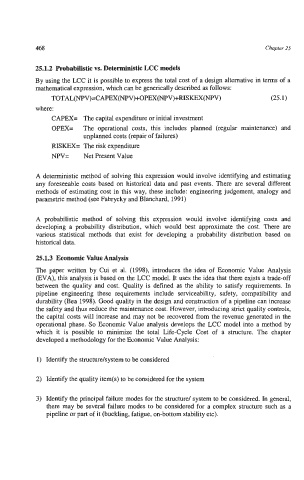Page 501 - Pipelines and Risers
P. 501
468 Chapter 25
25.1.2 Probabilistic vs. Deterministic LCC models
By using the LCC it is possible to express the total cost of a design alternative in terms of a
mathematical expression, which can be generically described as follows:
TOTAL(NPV)=CAPEX(NPV)+OPEX(NF'V)+RISKEX(N) (25.1)
where:
CAPEX= The capital expenditure or initial investment
OPEX= The operational costs, this includes planned (regular maintenance) and
unplanned costs (repair of failures)
RISKEX= The risk expenditure
NPV= Net Present Value
A deterministic method of solving this expression would involve identifying and estimating
any foreseeable costs based on historical data and past events. There are several different
methods of estimating cost in this way, these include: engineering judgement, analogy and
parametric method (see Fabrycky and Blanchard, 1991)
A probabilistic method of solving this expression would involve identifying costs and
developing a probability distribution, which would best approximate the cost. There are
various statistical methods that exist for developing a probability distribution based on
historical data.
25.1.3 Economic Value Analysis
The paper written by Cui et al. (1998), introduces the idea of Economic Value Analysis
(EVA), this analysis is based on the LCC model. It uses the idea that there exists a trade-off
between the quality and cost. Quality is defined as the ability to satisfy requirements. In
pipeline engineering these requirements include serviceability, safety, compatibility and
durability @ea 1998). Good quality in the design and construction of a pipeline can increase
the safety and thus reduce the maintenance cost. However, introducing strict quality controls,
the capital costs will increase and may not be recovered from the revenue generated in the
operational phase. So Economic Value analysis develops the LCC model into a method by
which it is possible to minimize the total Life-Cycle Cost of a structure. The chapter
developed a methodology for the Economic Value Analysis:
1) Identify the structure/system to be considered
2) Identify the quality item(s) to be considered for the system
3) Identify the principal failure modes for the structure/ system to be considered. In general,
there may be several failure modes to be considered for a complex structure such as a
pipeline or part of it (buckling, fatigue, on-bottom stability etc).

